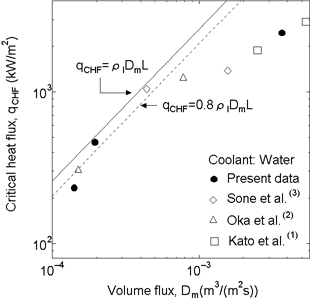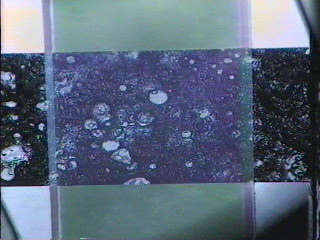RESULTS AND DISCUSSION
Effect of Spray Volume Flux on CHF (Normal Gravity)
Figure 5 plots the CHF vs. spray-volume-flux data for water obtained
in the present and the previous experiments under the terrestrial condition.
Also indicated in Fig. 5 are the ideal qCHF-Dm relation, qCHF = rlDmL,
and an empirical correlation due to Monde(5), qCHF * 0.8rlDmL; where rl
is the mass density of sprayed liquid, Dm is the mean spray volume flux,
and L is the latent heat of vaporization of the liquid. The authors* experimental
data show a tendency to deviating from any linear qCHF - Dm relation with
an increase in Dm beyond 1.0×10-3 m3/(m2.s). This fact is consistent with
a significant difference found in liquid-to-heater contact behavior between
Dm levels less than 1.0×10-3 m3/(m2.s) and those above it (see Fig. 6).
It is reasonable to assume that gravity effect may change with a variation
in liquid-heater contact mode. Thus, two Dm regions are distinguished here
for the convenience of discussing gravity effect on spray-cooling heat
transfer in a later part of this paper:
(a) low spray volume flux region (Dm < 1.0×10-3 m3/(m2.s)) in which
droplets having impinged upon the heater surface hardly interact each other
and completely vaporize, and
(b) high spray volume flux region (Dm < 1.0×10-3 m3/(m2.s)) in which
droplets integrate into liquid films spread over the heater surface.
It may be said alternatively that the low spray volume flux region represents
the Dm range in which qCHF is approximated by Monde*s correlation with
a reasonable accuracy and that the high spray volume flux region represents
the Dm range in which qCHF is no longer approximated by Monde*s correlation
because of an incompleteness of vaporization of the liquid on the heater
surface.

Fig. 5 Variation of CHF with Water-Spray Volume Flux
|
|

(a) Low Spray Volume Flux (Dm = 1.97×10-4 m3/(m2.s), q = 429.9
kW/m2)

(b) High Spray Volume Flux (Dm = 3.70×10-3 m3/(m2.s), q = 1220.5
kW/m2)
Fig. 6 Observations of ITO-coated Surface of a Glass-Prism Heater
Exposed to a Water Spray
Effect of Heater Orientation (Normal Gravity)
In advance of the parabolic flight experiments, a series of terrestrial
experiments were performed, using the Copper block heater set to face upward
or downward, to examine the effect of heater orientation on the spray-cooling
heat transfer. Figure 7 shows the results obtained with water sprayed at
a flux in the low spray volume flux region. The effect of the heater-surface
orientation is found to be appreciable only in the film boiling region.
The heat transfer coefficient in the film boiling region may be reduced
by half at the maximum by reversing the heater-surface orientation.
According to Shoji(6), the behavior of liquid droplets sprayed onto
a heater surface in the film boiling region was classified into the following
two categories with respect to the Weber number, We * rldmVm2/s, where
s is the surface tension of the drop-forming liquid.
|